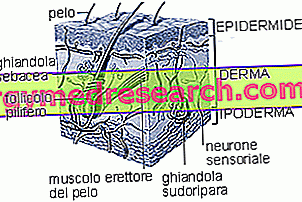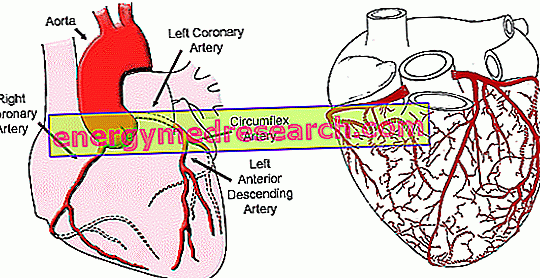
Skin: Structure and Functions
The skin or skin is the organ that covers the body; it consists of epithelial tissue, connective tissue and various annexes.

The skin participates both in the vegetative life and in the life of the whole organism's relationship and, in addition to the protective life, it performs other varied important functions: secretory function, thermoregulatory function, immune function and sensory function. Anatomically, the skin is made up of three overlapping layers: epidermis, dermis, hypodermis.
The epidermis, keratinized stratified pavement epithelium, is the most superficial tissue of the skin; it consists of various cellular layers (basal layer, spiny, grainy, horny), each of which has specific shapes and functions. The type of cells most represented in the epidermis is given by keratinocytes, which synthesize keratin and accumulate inside them, differentiating and migrating outwards to form, at the end of their activity, the corneocytes, which constitute the stratum corneum. (in contact with the external environment).
In the epidermis, in addition, there are four other types of cells: Langerhans cells, lymphocytes, Merkel cells and melanocytes . The latter are dendritic cells migrated, in an embryonic age, from the neural crest to the epidermal basal layer; the melanocytes, which extend between the keratinocytes completely, are responsible for the synthesis of melanin, a pigment with a variable chemical structure that is formed in the melanocyte starting from the amino acid tyrosine, due to the action of the tyrosinase enzyme and oxygen.
Melanin, which is brown in the eumelanic subjects and in the red phaeomelanic subjects, has a protective function against damage caused by ultraviolet radiation. Melanocytes make up about 5% of the epidermis and follicle cell population.
Skin colour
The color of healthy skin is the result of the presence of different pigments and factors:
- hemoglobin, contained in red blood cells, gives the skin a shade varying from pink to red;
- the carotene, contained in the adipocytes of the hypodermis, has a yellow-orange color;
- keratin, present in keratinocytes, gives the skin a yellow-white base color, which varies according to the thickness of the stratum corneum;
- the blood vessels present in the dermis, based on the number, depth and degree of oxygenation of the blood, contribute to giving the skin red-bluish tones;
- melanin .
Skin coloration depends mainly on constitutional melanin pigmentation, which is genetically determined, but can also be induced by exogenous factors, such as sun exposure, or endogenous factors, such as hormonal changes.
Melanin synthesis
Melanocytes and Melanogenesis
The genetically determined skin pigmentation is an ethnic character and does not depend on the number of melanocytes, which is approximately equal in all breeds, but on their melanogenetic activity and on the degree and mode of depletion of melanosomal granules or melanosomes.

Melanin, produced by melanocytes, accumulates in melanosomes, organelles that, once mature, are transferred inside the keratinocytes, where the melanin is arranged around the cell nucleus, carrying out its protective activity. In dark skin the melanosmi are larger and suffer a slower degradation than the melanosomes of the clear skin.
Melanin originates in melanosomes following an irreversible biological process, promoted by the enzyme tyrosinase starting from the amino acid tyrosine. The tyrosine is hydroxylated to 3, 4-hydroxyphenylalanine (L-DOPA) by the action of tyrosinase, which then oxidizes L-DOPA to o-dopachinone. The latter can self-oxidise leading to the formation of dopacrome and, subsequently, originating di-hydroxy-indole-2-carboxylic acid, until the formation of eumelanin, a brown-black polymer present in greater quantities in subjects with complexion dark. Alternatively, in the presence of cysteine and glutathione, dopachinone is converted into cystenyl-DOPA or glutathione-DOPA: this results in the formation of yellow-red pheomelanin, characteristic of subjects with fair complexions. Pheomelanins have a lower ability to defend against UV rays than eumelanins and have been hypothesized to have mutagenic properties due to their pro-oxidant capacities.
Control of Melanogenesis
Melanogenesis is controlled by various factors, both genetic and hormonal. However, the key enzyme that regulates the melanogenesis process is tyrosinase, a glycoprotein found on the membrane of melanosomes and activated by UV radiation .
Many other factors can influence its activity, including prostaglandin E2, an inflammatory mediator produced by keratinocytes, histamine, but also growth factors that stimulate the proliferation of melanocytes, and some fatty acids, such as palmitic acid.
phototypes
The melanin pigmentation has an important defensive function, as it protects the skin from the harmful action of UV rays.
On the basis of the reactivity of the skin in the solar radiation sources, six phototypes can be distinguished:
- Phototype I: very light skin, it is always burnt and never tans
- Phototype II: blond or red hair, minimal tan, easy to burn
- Phototype III: tans after adequate exposure and does not burn easily
- Phototype IV: dark complexion and hair, never burns
- Phototype V and VI: hyperpigmented skin (dark-skinned, negroid subjects)



